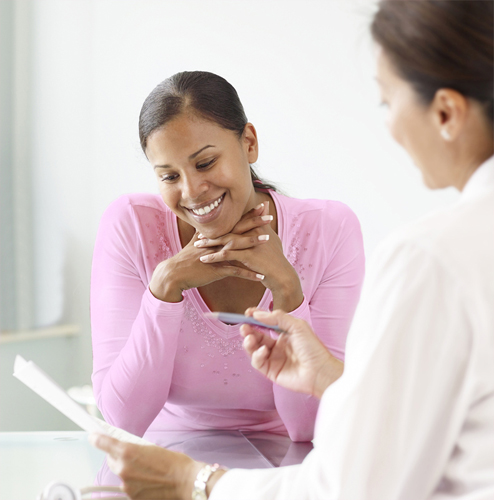This is Day 7 of your Menstrual Cycle 273 days to go…
When you’re trying to get pregnant, you need to take your age into account because your fertility will change as you get older.
What’s happening inside
Here an egg can be seen, in orange, developing in the ovary. The
cells of the follicle, in which it is contained, can be seen
surrounding the egg. At birth, baby girls have millions of follicles
present in their ovaries.

In about a week’s time you are likely to ovulate.
At the start of puberty, you had no more than about 400 eggs in your
ovaries, and will have made no new eggs. Your lifetime of eggs were
there when you were born. Given these facts, it’s hardly a surprise that
your fertility falls as you age.
Women 20–24 are generally
at their most fertile and although, for most women, periods continue
until their early fifties, the rate of fertility gradually lowers in the
30s, 40s, and 50s and the rate of chromosomal abnormalities and
miscarriage increases. Nonetheless, every year thousands of babies are
born to women in their late thirties and forties. Women can conceive
beyond that age, which is why doctors advise menopausal women to use
contraception for two years after their last period.
If, however, you’re
hoping to start a family, it’s safe to assume that fertility begins to
fall off sharply after age 35. Your age also affects the quality of your
eggs. In women in their early 20s, around 17 percent of eggs have a
chromosomal abnormality, but the figure rises to over 75 percent in
women in their 40s. Chromosomal problems increase the chances of having a
child with a disorder such as Down syndrome.
If you’re
concerned about your fertility, it is possible to have a blood test that
can give an indication of your remaining ovary function so that you
know how much reproductive time you have left. While some tests are
based on levels of FSH (see This is Day 4 of your Menstrual Cycle) and estrogen, newer tests use other markers found in the blood, such as anti-Mullerian hormone (AMH) and inhibin B.
But making a baby
depends on more than releasing an egg; it must travel down the fallopian
tube, be fertilized, implant, and the pregnancy be maintained. There’s
also the father’s contribution to consider (see The male biological clock?).
The follicle lies below the surface
of the ovarian wall and protrudes just prior to ovulation. The follicle
is most likely to rupture and release an egg mid-cycle, around days 13
and 14 of a 28-day cycle.
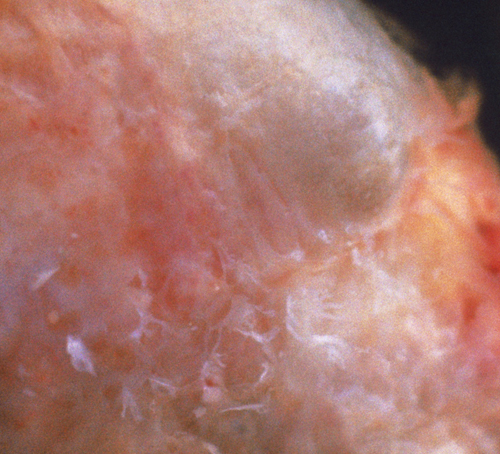
The male biological clock?
A man can continue to make sperm
more or less throughout his life, so you might not expect male
fertility to fall significantly. There are plenty of older fathers
around that seemingly prove this.
Recent research from
France, however, found that men over 35 took a lot longer to get their
partner pregnant. For those who conceived, there was a slightly higher
risk of miscarrying. This is because sperm from older men is more likely
to contain damaged DNA. So although older couples do conceive, it’s a
fact that men, like women, pass their peak fertility.
Sperm have a long and perilous journey of 12–16 in (30–40 cm) to reach the egg.
This is why nature is
bountiful when it comes to sperm, producing many millions with each
ejaculation. On average each ejaculation produces 2–8 ml of semen, with
over 40 million sperm in each milliliter.
Your 2nd Week
Toward the end of this
week, one of the eggs in your ovaries is likely to have reached full
maturity. Ovulation occurs as the egg, under the influence of hormones,
bursts out of its follicle. If it meets a sperm, you may become
pregnant. Now is the time to enjoy lots of sex with your partner, so go
for it—as often as you like. If you have any anxieties about fertility,
try to put them aside and relax.
NOTE
Your “fertile window” is approaching and this could be the time you conceive
Ovulation
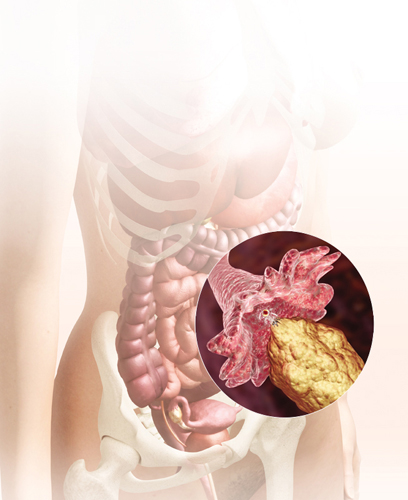
This is Day 8 of your Menstrual Cycle 272 days to go…
By the end of this week
you’re likely to have ovulated. It’s a good idea to know the signs that
indicate you’re at your most fertile.
What’s happening inside
Here, three developing ovarian follicles can be seen in white.
The inner circle of each is the egg. Of the follicles shown, it is
likely that only one will fully mature at ovulation and release an egg.
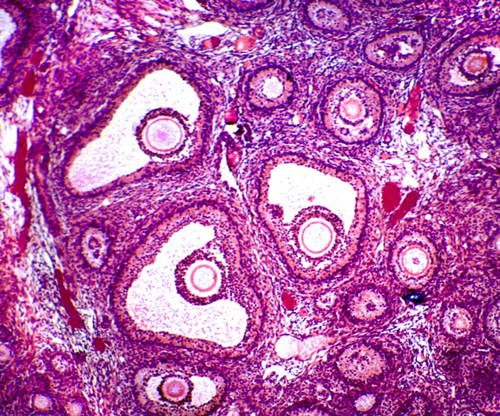
This is week two of your cycle.
You will probably ovulate by the end of this week and will therefore be
fertile. However, the fertile window can be from 5 days before
ovulation to 12–24 hours after as sperm can survive for 5 days inside
you. If your periods are regular, ovulation can be easier to track, but
you may want to use other methods, such as looking out for natural signs
(see Are you ovulating?) or using an ovulation kit. Remember, however, the best way to conceive is to have sex regularly.
While they are
useful, testing kits are expensive and can be counterproductive because
they make sex more clinical and less enjoyable. They work by testing the
urine to detect a surge in LH, the hormone that triggers egg release.
Always follow the
instructions given. Testing between 10 am and 8 pm should be fine, but
try to aim for roughly the same time every day. After a positive test,
you should ovulate 12–36 hours later. Results are about 99 percent
accurate but occasionally the result is a false positive. Results can
occasionally give a false negative, especially if you’ve drunk a lot of
water. If your test was negative, do another one the next day. Once you
have a positive result, you can stop testing for that month.
Are you ovulating?
This week, look out for:
Lower abdominal pain at ovulation, called mittelschmerz (the German for “pain in the middle”).
Basal body temperature (your temperature when you first wake in the morning) rising slightly.
Cervical mucus—the
cervix produces secretions, which become wetter, clearer in color, and
stretchy, resembling raw egg white, just before ovulation. This
indicates the start of your fertile phase.
Changes during the menstrual cycle
Body temperature
can be seen at the top of the chart, rising sharply right after
ovulation. The bottom section shows cervical secretions. These begin in
the days leading up to ovulation, starting off moist and sticky, then
becoming wetter and stretchy at your most fertile time.
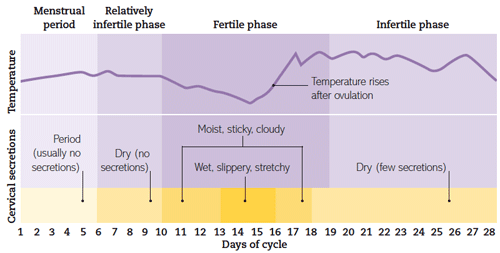
If you feel some of the cervical mucus with your fingers, you will find you can stretch it out. This is a sign that you are about to ovulate.
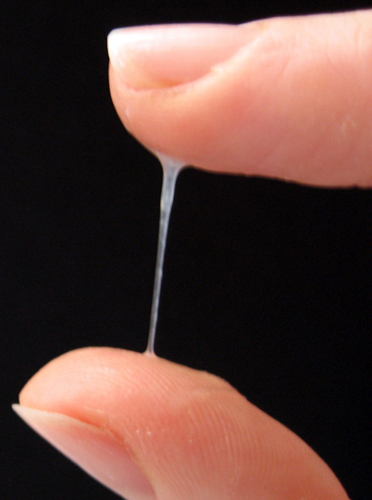
This is Day 9 of your Menstrual Cycle 271 days to go…
While you wait to ovulate, fascinating changes are occurring in your ovaries as your follicles mature to release an egg.
What’s happening inside
In your partner’s body, sperm is constantly being produced. Here
the sperm cells can be seen: they consist of a head (green), which
contains the genetic material, and fertilizes the egg, and a tail
(blue), which propels the sperm along.
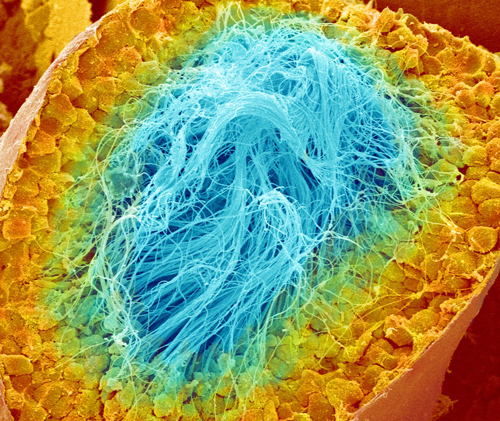
In the time leading up to ovulation,
which will happen later this week, the most advanced follicle moves to
the surface of the ovary, ready to release its precious cargo. While you
were having your period, around 15–20 follicles were developing in your
ovaries.
Both of your ovaries
contribute to follicle growth, but usually only one ovary brings a
follicle to ovulation. Which ovary it is seems to depend on chance since
ovaries are not on a strict rotation. As the follicles grow, they
enlarge greatly, filling with fluid secreted inside the follicle. Some
women release more than one egg some months (see as a matter of fact) and if both are fertilized, it will mean nonidentical twins are conceived.
By the time of
ovulation, the follicle will be about 1 in (2 cm) in diameter, while the
egg is just about visible without a microscope.
To mature, follicles need FSH (follicle-stimulating hormone) produced by the brain’s pituitary gland (see Changes during the menstrual cycle), but their early growth doesn’t appear to rely on it. It may, however, depend on other hormones and chemicals.
… Dads
Dads: your diet counts too
It’s never too late to start eating well
if you want to become a dad. But because sperm take some weeks to
mature, ideally start eating a healthy diet at least three months before
conception. There are supplements, but most vitamins and minerals work
better in the form of real food.
Antioxidants A diet rich in anti-oxidants, including vitamins A, C, and E, selenium, and zinc, helps prevent damage to sperm DNA.
Selenium may also help sperm penetrate the outer layer of the egg. Eat tuna, wheatgerm, whole grains, and sesame seeds.
Zinc is present in large amounts in semen. Eat fish, lean meat, shellfish, turkey, chicken, eggs, whole grains, rye, and oats.
Manganese
is another element that could help male fertility. Eat leafy vegetables
(including broccoli) carrots, eggs, whole grains, and ginger.
Essential fatty acids may improve sperm motility. Eat oily fish, such as mackerel, salmon, and sardines, flaxseed and linseed, and kiwi fruit.
Specialized medical advice
If you have any ongoing medical problems,
go to see your doctor before you start trying to conceive. Conditions
such as diabetes, asthma, high blood pressure, heart trouble, a previous
bout of deep vein thrombosis (DVT) , thyroid conditions, sickle-cell disease, and epilepsy can all impact a pregnancy.
The effect will depend on
the individual condition and a specialist’s advice and care will be
needed. If you’re in any doubt about how your own medical history may
affect a pregnancy, check with your doctor before you start trying to
conceive.
